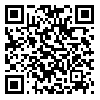Volume 15, Issue 3 (Vol.15, No.3 2019)
irje 2019, 15(3): 247-258 |
Back to browse issues page
Download citation:
BibTeX | RIS | EndNote | Medlars | ProCite | Reference Manager | RefWorks
Send citation to:



BibTeX | RIS | EndNote | Medlars | ProCite | Reference Manager | RefWorks
Send citation to:
Ahmadabadi A, Aghajani H, Khadem Rezaiyan M, Zanganeh M, Tavousi S, Hadianfar A. Spatial Analysis of Hospitalized Burn Injuries and Related Risk Factors in Mashhad, Iran. irje 2019; 15 (3) :247-258
URL: http://irje.tums.ac.ir/article-1-6384-en.html
URL: http://irje.tums.ac.ir/article-1-6384-en.html
1- Assistant Professor, Surgical Oncology Research Center, Mashhad University of Medical Sciences, Mashhad, Iran
2- Department of Sustainable Development Urban and Regional, Academic Center for Education, Culture and Research (ACECR), Khorasan Razavi Organization, Mashhad, Iran
3- Assistant Professor, Clinical Research Development Unit, Faculty of Medicine, Mashhad University of Medical Sciences, Mashhad, Iran
4- Faculty of Medicine, Mashhad University of Medical Sciences, Mashhad, Iran
5- Student Research Committee, Mashhad University of Medical Sciences, Mashhad, Iran; Department of Epidemiology and Biostatistics, Mashhad University of Medical Sciences, Mashhad, Iran ,hadianfara931@mums.ac.ir
2- Department of Sustainable Development Urban and Regional, Academic Center for Education, Culture and Research (ACECR), Khorasan Razavi Organization, Mashhad, Iran
3- Assistant Professor, Clinical Research Development Unit, Faculty of Medicine, Mashhad University of Medical Sciences, Mashhad, Iran
4- Faculty of Medicine, Mashhad University of Medical Sciences, Mashhad, Iran
5- Student Research Committee, Mashhad University of Medical Sciences, Mashhad, Iran; Department of Epidemiology and Biostatistics, Mashhad University of Medical Sciences, Mashhad, Iran ,
Abstract: (2552 Views)
Background and Objectives: Burns are tragic events with considerable mortality rates. This study was conducted to analyze the spatial pattern of burns and identify the factors associated with the burn injuries in Mashhad, Iran.
Methods: This retrospective cross-sectional study was conducted in patients hospitalized in Imam Reza Hospital Burn Center, Mashhad, which is the only referral burn center in the northeast of Iran. Spatial generalized linear models (Poisson and negative binomial) were used to model the association between socio-economic characteristics and the incidence of burn injury.
Results: A total of 1044 acute burn patients (69.9% male, 30.1% female) were reviewed. Most of the burned patients were in the age group 20-29 years (41.4%). The most common cause of burn injury was flame (64.6%). The local test of spatial autocorrelation confirmed that the burns had cluster pattern in the central areas of the city and the worn-out urban texture was at higher risk of burns. The results of model showed that the percentage of worn-out urban texture (IRR =1.007; 95%CI 1.005-1.008), literacy (IRR =0.98; 95% CI 0.95-0.99), percentage of employed women (IRR =0.96; 95%CI 0.92-0.99), unemployment rate (IRR =0.92; 95%CI 0.85-0.99) and percentage of margination (IRR =1.006; 95%CI 1.005-1.008) were associated with burns.
Conclusion: Based on the findings, socio-economic and environmental characteristics are associated with the incidence of burn injuries in different areas. The results of this study could be used to design burn prevention strategies, especially in the high-risk areas and groups.
Methods: This retrospective cross-sectional study was conducted in patients hospitalized in Imam Reza Hospital Burn Center, Mashhad, which is the only referral burn center in the northeast of Iran. Spatial generalized linear models (Poisson and negative binomial) were used to model the association between socio-economic characteristics and the incidence of burn injury.
Results: A total of 1044 acute burn patients (69.9% male, 30.1% female) were reviewed. Most of the burned patients were in the age group 20-29 years (41.4%). The most common cause of burn injury was flame (64.6%). The local test of spatial autocorrelation confirmed that the burns had cluster pattern in the central areas of the city and the worn-out urban texture was at higher risk of burns. The results of model showed that the percentage of worn-out urban texture (IRR =1.007; 95%CI 1.005-1.008), literacy (IRR =0.98; 95% CI 0.95-0.99), percentage of employed women (IRR =0.96; 95%CI 0.92-0.99), unemployment rate (IRR =0.92; 95%CI 0.85-0.99) and percentage of margination (IRR =1.006; 95%CI 1.005-1.008) were associated with burns.
Conclusion: Based on the findings, socio-economic and environmental characteristics are associated with the incidence of burn injuries in different areas. The results of this study could be used to design burn prevention strategies, especially in the high-risk areas and groups.
Type of Study: Research |
Subject:
Epidemiology
Received: 2019/12/14 | Accepted: 2019/12/14 | Published: 2019/12/14
Received: 2019/12/14 | Accepted: 2019/12/14 | Published: 2019/12/14
Send email to the article author
| Rights and permissions | |
 |
This work is licensed under a Creative Commons Attribution-NonCommercial 4.0 International License. |





